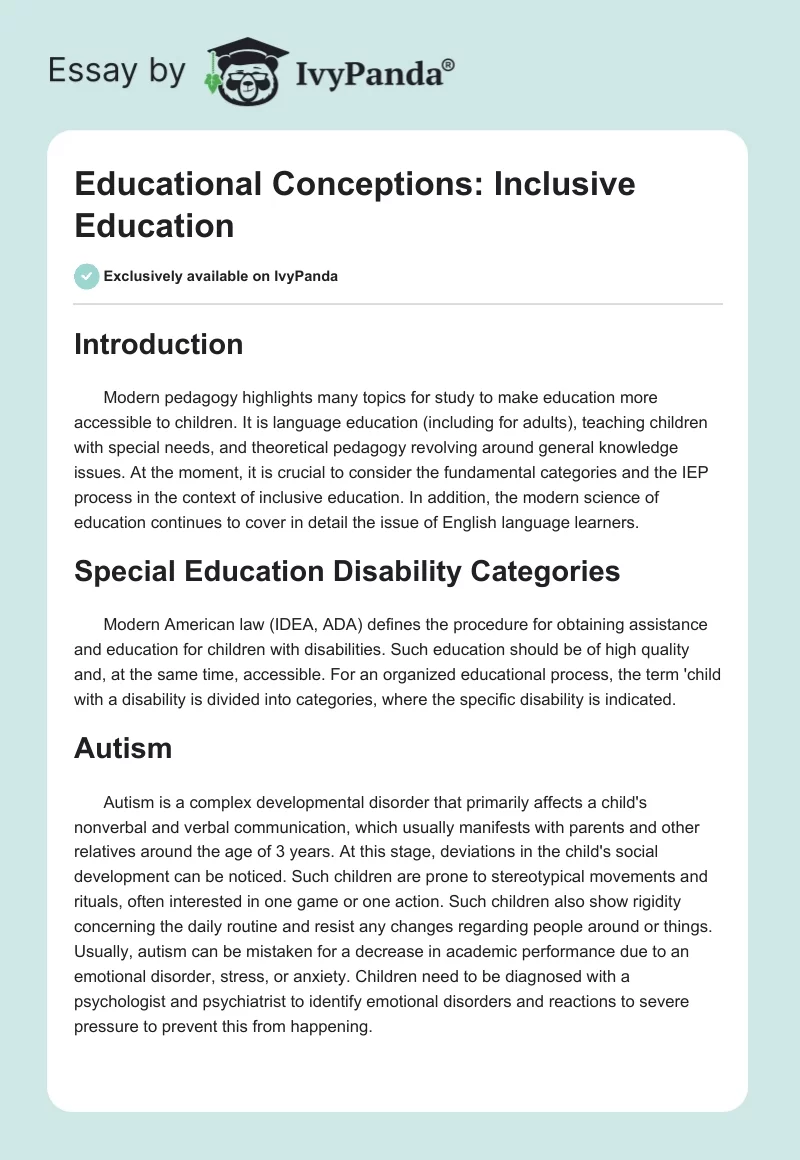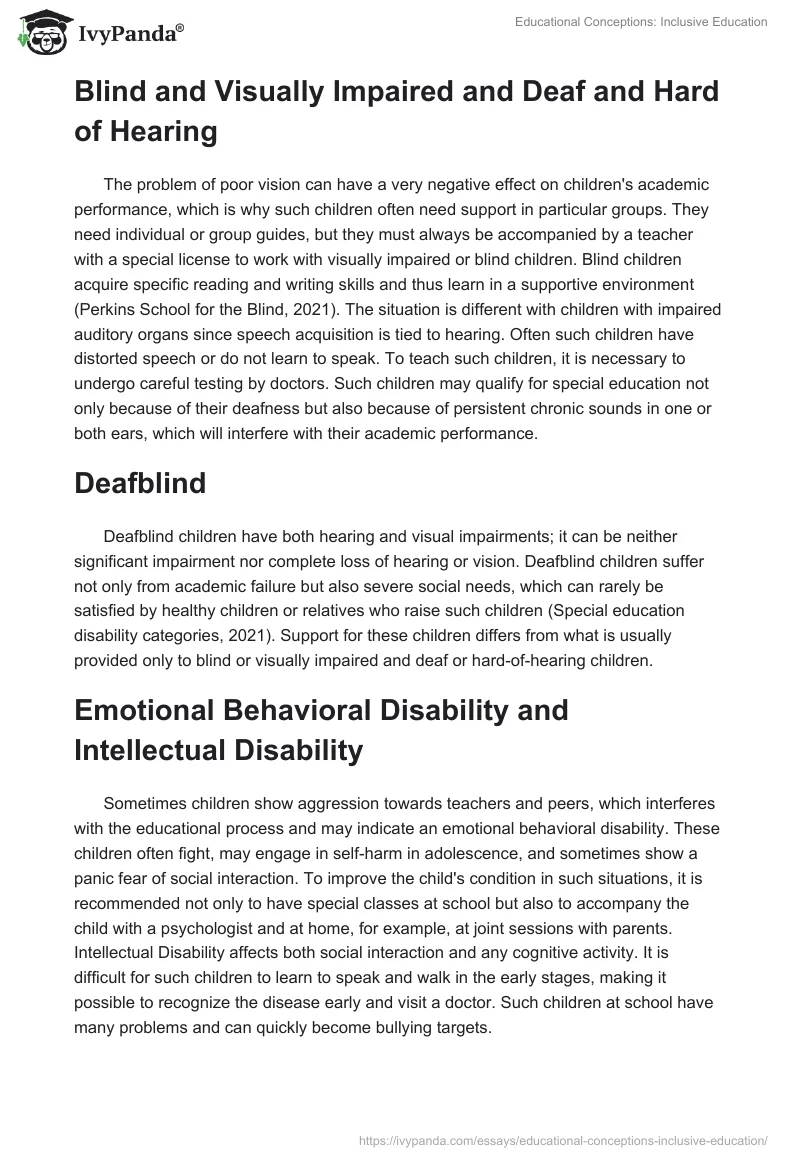Introduction
Modern pedagogy highlights many topics for study to make education more accessible to children. It is language education (including for adults), teaching children with special needs, and theoretical pedagogy revolving around general knowledge issues. At the moment, it is crucial to consider the fundamental categories and the IEP process in the context of inclusive education. In addition, the modern science of education continues to cover in detail the issue of English language learners.
Special Education Disability Categories
Modern American law (IDEA, ADA) defines the procedure for obtaining assistance and education for children with disabilities. Such education should be of high quality and, at the same time, accessible. For an organized educational process, the term ‘child with a disability is divided into categories, where the specific disability is indicated.
Autism
Autism is a complex developmental disorder that primarily affects a child’s nonverbal and verbal communication, which usually manifests with parents and other relatives around the age of 3 years. At this stage, deviations in the child’s social development can be noticed. Such children are prone to stereotypical movements and rituals, often interested in one game or one action. Such children also show rigidity concerning the daily routine and resist any changes regarding people around or things. Usually, autism can be mistaken for a decrease in academic performance due to an emotional disorder, stress, or anxiety. Children need to be diagnosed with a psychologist and psychiatrist to identify emotional disorders and reactions to severe pressure to prevent this from happening.
Blind and Visually Impaired and Deaf and Hard of Hearing
The problem of poor vision can have a very negative effect on children’s academic performance, which is why such children often need support in particular groups. They need individual or group guides, but they must always be accompanied by a teacher with a special license to work with visually impaired or blind children. Blind children acquire specific reading and writing skills and thus learn in a supportive environment (Perkins School for the Blind, 2021). The situation is different with children with impaired auditory organs since speech acquisition is tied to hearing. Often such children have distorted speech or do not learn to speak. To teach such children, it is necessary to undergo careful testing by doctors. Such children may qualify for special education not only because of their deafness but also because of persistent chronic sounds in one or both ears, which will interfere with their academic performance.
Deafblind
Deafblind children have both hearing and visual impairments; it can be neither significant impairment nor complete loss of hearing or vision. Deafblind children suffer not only from academic failure but also severe social needs, which can rarely be satisfied by healthy children or relatives who raise such children (Special education disability categories, 2021). Support for these children differs from what is usually provided only to blind or visually impaired and deaf or hard-of-hearing children.
Emotional Behavioral Disability and Intellectual Disability
Sometimes children show aggression towards teachers and peers, which interferes with the educational process and may indicate an emotional behavioral disability. These children often fight, may engage in self-harm in adolescence, and sometimes show a panic fear of social interaction. To improve the child’s condition in such situations, it is recommended not only to have special classes at school but also to accompany the child with a psychologist and at home, for example, at joint sessions with parents. Intellectual Disability affects both social interaction and any cognitive activity. It is difficult for such children to learn to speak and walk in the early stages, making it possible to recognize the disease early and visit a doctor. Such children at school have many problems and can quickly become bullying targets.
Orthopedic Impairment and Other Health Impairment
Orthopedic disorders, severe ones, affect children’s academic performance; such conditions include past amputations, congenital absence of limb(s), and clubfoot. Childhood illnesses, such as poliomyelitis, negatively impact learning and sometimes make children the center of ridicule from classmates. These disorders include any skeletal disorders the child receives due to mechanical trauma, past illness, or birth. Another health impairment is a broad list of conditions caused by a chronic disease (asthma or heart disease, for example) or severe health problems. Such children live from an early age with prohibitions and cannot develop without auxiliary medications and equipment.
Significant Developmental Delay and Specific Learning Disabilities
Significant Developmental Delay is a specific condition of a preschool or elementary school child (3 to 9 years old) when the child shows difficulty in learning, remembering, writing, and speaking. In addition, such children often have problems communicating with peers, parents, and caregivers. Social and emotional instability and difficulties with adaptation are observed (Lee, 2022). He needs support until the child begins to socialize with other teenagers and reaches this level. Specific Learning Disabilities are a list of psychological, cognitive, and brain injury conditions that prevent a child from improving academic performance. Such violations are manifested in the inability to master speech, writing, and mathematical calculation. Children cannot read, write, or spell because they do not remember the mechanism. These disorders include aphasia, dyslexia, and minimal brain dysfunction.
Speech and Language and Traumatic Brain Injury
Speech problems often have an inactive effect on academic performance and instill in the child complexes and painful feelings of self-doubt. Self-doubt interferes with building relationships with others, and the child closes in on himself more strongly, losing motivation to improve his speech. Speech dysfunction can meet such children not only in the early stages but also in adulthood later. Traumatic brain injuries are exclusively external disorders of the brain. These include neither congenital diseases nor transferred injuries received mechanically. Traumatic brain injuries negatively affect speech, memory, and judgment abilities and harm communication with others. Thus, such children suffer not only in terms of pedagogy and academic performance but cannot receive communication and attention from their peers, subsequently becoming outsiders.
What is the IEP Process?
IEP refers to the learning process and the meaning of learning for a child with a specific disability. It includes testing, communication with parents, and joint sessions to determine a child’s progress, changes, or transfer to another school or state. The IEP develops an individual learning program for the child, which is discussed on an equal footing with parents and approved by teachers. At the same time, the IEP is a complex documentary, educational and medical, that closely records the progress or regression of the child and how the program is going. Documentation of any program details is an essential legal aspect that requires attention. At the same time, the IEP is a tool to improve the educational level of a child with a disability and his psychosocial development.
The IDEA and IEP Process
Since 2004, IDEA has been part of the federal law on the availability and quality of education for children with disabilities. IDEA dictates the conditions under which the leaders of the IEP process must adapt. These prerequisites are team meetings (teachers, parents, psychologists, and children), measurement of progress, transitions from course to course, student transfers, peer-reviewed research, and IEP flexibility.
IEP as Meeting
The IEP process and meetings are often shifted towards a single concept since meetings are integral to the IEP setting. Meetings should be face-to-face with all participants present. Teachers and parents should communicate as equals to achieve realistic results and current uniform requirements for the child to avoid dissonance. Often, children with disabilities need their parents to accompany them during their education. So they feel calmer and more confident, and parents can directly observe their victories and failures (Perkins School for the Blind, 2021). During meetings, teachers and parents form the expected results, basing the program and the latest research in child development, psychology, pedagogy, and medicine.
IEP and Its Documentation
The documentation should address any changes to the program and the original provisions. At the same time, the documentation does not reflect the daily lesson plan and is not a lesson schedule. IEP documentation reflects the whole year of the child’s education, and parents use the services of the IEP for an entire year, then officially extending or terminating them. This documentation is also not a record of the child’s progress and does not contain a list of grades. Grade lists are specific documents and records that do not have official status. The IEP is not responsible on paper for improving the child’s condition, and parents should understand that changes to the program may not work.
IEP as Instrument
As a tool for managing the educational process, the IEP provides a child with special needs with qualitative changes in education. It enables the child to avoid a massive gap between him and his peers (IEP process, n.d). However, such a tool must remain flexible and change according to the child’s needs and maturation. Every year, the IEP must be changed under the guidance of teachers and parents, fixing changes in the documentation compiled after the meetings. The logical and equal combination of seminars, communication, and careful documentation makes the IEP an excellent tool for helping children with disabilities.
English Language Learners (ELL): Definition
In the United States, such students are sometimes considered beginner bilinguals. The concept of ELL is often shifted towards ESL (English as a Second Language) and has a lot to do with minorities and cultural diversity in the US. It is the minorities who experience the most severe problems in socialization and education as ELLs.
English Language Learners and Disabilities
ELL with a disability includes children whose native language is not English and who suffer from any disease from the IDEA category. Specialists can often meet children with emotional disorders since ELL has difficulty adapting, leading to anger, aggression, and uncontrollable crying. Sometimes such children develop PTSD, having escaped the war zone in the United States (Villegas et al., 2018).
Teaching Programs
The division of suitable programs for ELL follows the principle of isolation usually, which brings with it both advantages and disadvantages. The push-in program is the most social and is aimed at the constant stay of the student in the team (Hallowell & Jensen, 2010). The pull-out program is a classic take on language learning face-to-face with a native speaker in direct interaction that does not involve other students.
Most Common Difficulties
The problems faced by ELLs are usually very diverse, and it may take a separate study and a separate presentation to cover them in detail. They depend on the particular context, family, experience of moving, and the first stages of socialization and adaptation to a new place.
Strategies for Help
One of the easiest ways to help ELLs is through cultural engagement and offers to match native and English. It will be helpful to provide the students to talk in English about their native culture, art, and cuisine (Gupta, A, 2019). High-tech equipment in the classroom also helps children learn faster, allowing teachers to show pictures and drawings along with text, building an associative array for the student. Teachers must show patience and understanding towards their students, which should accompany any chosen strategy.
Conclusion
Thus, the topics presented are among the most important in modern education, focused on diversity and assistance to those who most often cannot receive or apply for it.
References
Gupta, A. (2019). Principles and practices of teaching English language learners. International Education Studies, 12(7). Web.
Hallowell, E. M., & Jensen, P. S. (2010). Superparenting for ADD. In No Title. Adfo Books.
IEP process. (n.d.). Special School District of St. Louis County.
Lee, M. J. A. D. (2022). The 13 disability categories under IDEA. Understood. Web.


